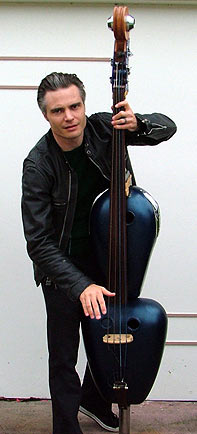Berkeleyan
Motorcycle luthier
ETS staffer Ezra Daly found an alternative to buying instruments. He makes - and sells - them his own way
![]()
| 23 February 2005
 The Venus de Moto is the first double-tank upright bass ETS staffer Ezra Daly designed and built. For Daly, who plays the basses he builds, instrument making is "an overblown hobby, one that's not yet a sustainable business in terms of sustaining me." (Photo courtesy Ezra Daly) |
A musician himself, Daly was "blown away" by the band's slap-bass player. Though he had played bass guitar in a punk-rock band in high school, he had never felt strongly connected to the instrument. But watching Elmers' bassist, Nick Mitchell, that night in Santa Cruz, Daly knew he'd found his axe, at least metaphorically.
What made matters tricky, however, was locating one that cost less than $1,000.
That's when Daly embarked on building his own slap bass, one designed for the more aggressive style of bass playing popularized half a century ago by the legendary Bill Black, Elvis Presley's original Sun Records bassist. A slap bass differs from a traditional upright bass not only in terms of the music it contributes to and the sounds it makes, but in its very construction. It's often outfitted with an amplifier pickup, explains Daly, and the strings are positioned closer to the neck and body of the instrument, much like the "lower action" that many standard guitarists adopt to compensate for picking style, string gauge, and other individualized factors.
To make his own slap bass, Daly began by investigating what "resonant chambers" he could find. He settled on the gasoline tank of a Moto Guzzi, "because it's one of the biggest motorcycle gas tanks around." After "chipping away at it with a rusty screwdriver and mallet" in his bedroom over the course of several months, he completed what he would eventually view as a prototype.
When he plugged in the instrument he christened Frankenbass and played its first notes, Daly says, it was "one of the best feelings I've ever had." Thus, a passion was born. He introduced the instrument at a 1996 UC Santa Cruz gig with a band called Buddys Riot. The response, says Daly, was "amazing. People stood in front of the stage staring at it - everybody wanted to talk about it and touch it."
Frankenbass, however, had its limitations. "When you press a stand-up bass against your body, the shoulder of the bass should rest nicely against your chest," says Daly. But because Frankenbass' shoulder barely reached his sternum, Daly went back to the drawing board and arrived at a two-tank design with an hourglass shape. "It was a much sexier bass," he says of the instrument he dubbed the Venus de Moto, offering "more of the sensation of a traditional upright bass."
Not long afterward, Daly joined a band in which he was required to play a bass guitar. A trip to the flea market yielded two hubcups, and in short order he created the Flying VW, a resonator bass guitar.
Over the years, Daly has honed his skills. He's taken woodworking and welding classes, along with "ones you wouldn't think of as applicable," such as a graduate-level course on sustainable and environmental business practices.
"A lot of traditional standup basses are made from rare woods like ebony," explains Daly, who mainly uses recycled parts and easily available woods. "When you put a bass through a pickup and an amplifier, no one in the world is going to be able to tell if it's made from ebony or a more sustainable wood, If you're not going to use an instrument in an acoustic setting, you don't need to use materials that aren't right for us to be using."
After fielding numerous inquiries at gigs about his bass-building fee, Daly launched a website (www.wrecknroll.com) to which he could steer potential customers as well as talent bookers interested in his bands. While at first he wasn't interested in going into business, Daly came to realize that selling the instruments was the only way he could afford to build them. His website receives more than 1,000 hits a month, though he suspects the fact the basses take six months or longer to produce probably puts off some potential customers. Not all his creations are expensive, though: He's sold a number of "gut bucket" basses - consisting of a metal wash bucket, string, and pole topped by car gearshift knob - that cost less than $100.
At one time, Daly worked full-time, took classes, played in three bands, and built basses. He's simplified his life considerably, now that he's only in the Lee Maverick Band, a group that plays cow punk, which, he says, "is very similar to psychobilly."
"I'm not into being an artist," maintains Daly. " I'm more of an engineering-minded musician who likes to create something functional."

